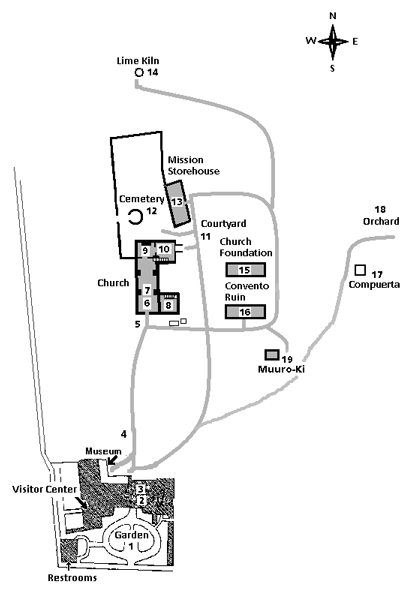
Tumacácori is special because of its history. That is why President Theodore Roosevelt made it a national monument in 1908. The National Park Service takes care of this park so everyone can see it, learn from it, and enjoy it.
How will you help take care of Tumacácori National Historical Park?
1 - Garden
3 - Mission Model
4 - Mission Grounds
6 - Nave
7 - Choir Loft
8 - Baptistery
9 - Sanctuary
10 - Sacristy
11 - Convento Courtyard
12 - Cemetery
13 - Storehouse
14 - Lime Kiln
16 - Convento Ruin
17 - Melhok Ki
18 - Compuerta
19 - Orchard
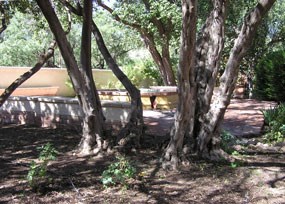
1 - Garden Father Kino (KEE-no) was a priest. The King of Spain sent him to start missions. The native people living here called their village Tumacácori (tu-mah-KAW-koh-ree). They asked Father Kino to come here. They called themselves O'odham (AW-aw-tum). It means "people" in their language. Father Kino and later priests brought horses, cattle, sheep, wheat, fruit trees, and tools made of metal. Can you find two kinds of fruit trees in this garden? 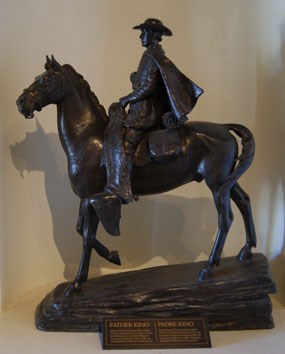
2 - Kino Statue People who knew Father Kino said he was kind and helpful. He traveled a lot to see new places and meet new people. Father Kino started over 20 missions. How could Father Kino travel a long way in a day? 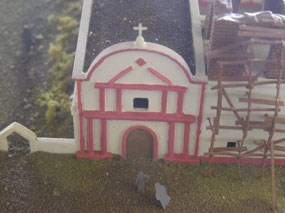
3 - Mission Model O'odham life changed after the priests arrived. In the missions, they learned new ways to farm, a different religion, and to speak Spanish. They started building houses with mud bricks called adobe (ah-DOE-bay). Look at the model. Do you see the same buildings outside? Why do you think some buildings are gone?
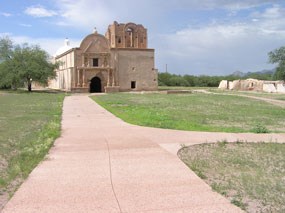
4 - Mission Grounds Imagine the mission grounds full of noise and activity! You would have experienced the clang of the blacksmith, the smell of wood smoke, and families with children going about their business. How do you think life would be different for a kid your age at Tumacácori? 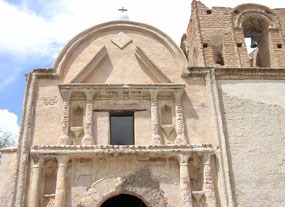
5 - Front of Church A church like this one was big to the people who lived here. O'odham houses had only one small room. The front of the church was painted with bright colors. Inside were more bright colors and beautiful statues of saints. Can you find some colorful paint on the front of the church? 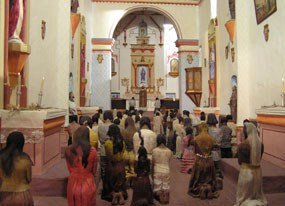
6 - Nave The long passageway inside the church is called the nave. It was painted and decorated with many colors. People attending church would have knelt on the hard floor during services and maybe prayed at one of the side altars along the walls. Count the side altars. What do you think stood in the niches above each altar? 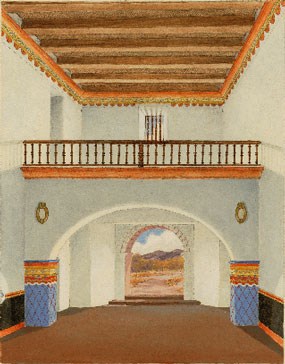
7 - Choir Loft The loft was inside over the front door of the church. Some girls and boys living in the village sang in the choir. Others played instruments such as flutes, harps, violins, and guitars. Would you like to be in a choir or play an instrument? 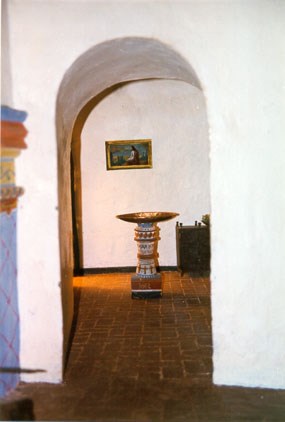
8 - Baptistry This room was the baptistery. Here, the priest baptized babies, children, and adults. It was how they became Catholics. It was a special time. The stairs lead to the choir loft entrance and to the bell tower. The tower could also be used as a lookout. Why might the village need a lookout? 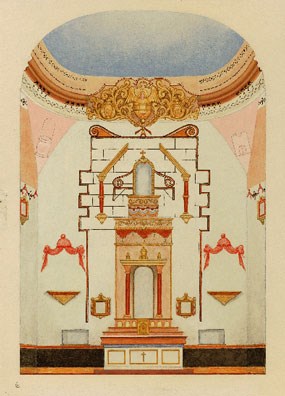
9 - Sanctuary In the sanctuary, the priest celebrated Mass. Mass is a church ceremony. This hole in the wall might have been a place to keep things used in the Mass. After the villagers left the area, the wood roof was taken away. The inside of the church was harmed by people, rain, wind, and sun. Can you find areas damaged by people and weather? 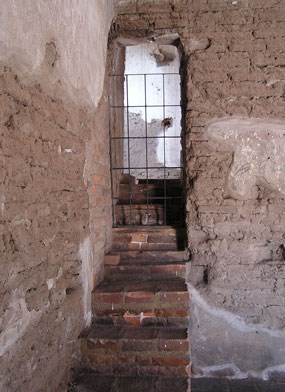
10 - Sacristy The sacristy is where the priest kept books and robes for Mass. On his desk, he wrote in mission record books about births, weddings, deaths, and other things. After the villagers left the mission, cowboys, soldiers, and other travelers camped in this room. Why is the ceiling black? 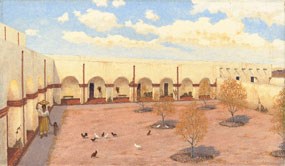
11 - Convento Courtyard The convento courtyard, straight ahead, was the center of community life at the mission. Look to your left to find the long, low hill that covers that ruins of workshops. Look to your right to find the last piece of the priest's house. This spot would have been under a cool, covered walkway perfect for meeting up with friends. Where is the center of your community back home? Why? 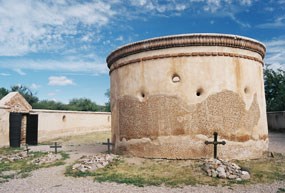
12 - Cemetery When a person died, the body was brought to the round building called a mortuary chapel. This is where family and friends came to pray for them. More than six hundred people were buried at Tumacácori. How do we know how many people are buried here? Hint: Remember the sacristy. 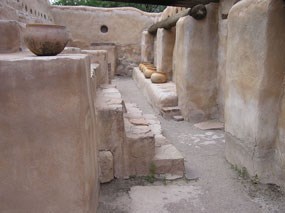
13 - Storehouse The mission storehouse was where the people kept the food they grew. The villagers stored wheat, corn, mesquite beans, squash, dried meat, and dried fruit here. Why are there stairs in this room? 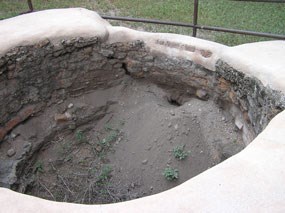
14 - Lime Kiln The lime kiln was a fire pit for heating limestone. After the rock became soft from the heat, it was pounded into powder. Then sand and water were added to make lime plaster. Plaster covered the adobe walls of the mission. What happens to adobe if it is not protected by plaster?
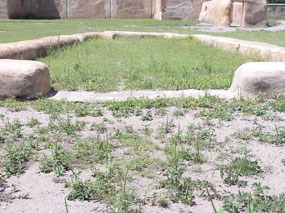
15 - Jesuit Church Foundation Please remember –do not walk on walls or touch them. The low wall outlines the foundation of the first church at the mission. Later the villagers began the hard work of building the big church that is still standing. Do you think they used the adobe bricks from this church for other buildings after the new church was finished? Why? 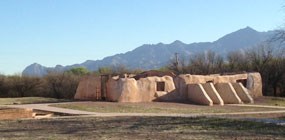
16 - Convento Ruin The long building around the courtyard was called the convento (cone-BEN-toe). The priest lived in this room. Other parts of the convento are gone. Some rooms were used for school, iron working, woodworking, grinding wheat and other jobs. Children would help adults with the work. What do you think life was like as a child growing up at Tumacácori? 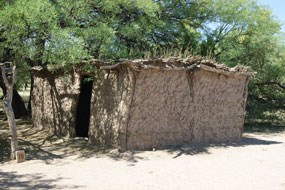
Before the Spanish came, an O'odham family lived in a ki (pronounced KEE) made of mud-covered sticks. To the side is a shaded place where the family would cook. They could go inside when it was cold, rainy, or windy.
Imagine living with your family in a ki. What would you like or dislike about living in a ki?
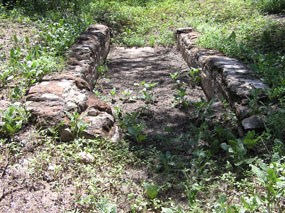
18 - Compuerta Acequia (ah-SAY-key-ah) is a Spanish word for irrigation ditch. The people of this mission built acequias to bring water to the mission gardens, fields, and orchards, and to this compuerta for washing clothes, dishes, or filling water containers. Where do you think the water that flowed in the acequias came from? 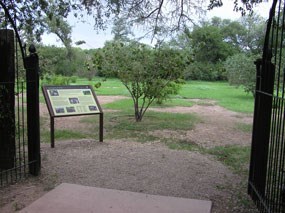
19 - Orchard You are in the area that was the mission's orchard and garden. They built an adobe wall around it to keep animals from eating fruits and vegetables. The fruit trees planted in rows include pomegranates, figs, and quinces. Priests brought these kinds of trees from Europe for mission orchards. Come inside! Can you figure out where the historic orchard walls were located? |
Last updated: February 4, 2025
